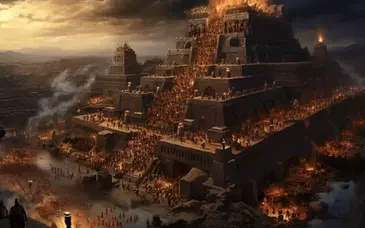Mayan Glyphs
The Peoples And Civilizations Of The Americas
Author: Michael Schwartz
Date: 1999
Document: Deciphering The Maya Glyphs
Of all the peoples of ancient America, the Maya developed the most
complex system of writing to record their history, religion, philosophy, and
politics. Maya hieroglyphs have baffled and fascinated researchers since the
1820s, when the first steps toward deciphering the rich glyphs and symbols of
Maya monuments, ceramics, and the few surviving Maya books were made. This
process continues, and although we are not yet able to read all the surviving
texts, those that have been deciphered have altered our view of Maya society
and its underlying beliefs.
One of the problems of decipherment was a false start. In the 16th
century, a Spanish bishop of Yucatan, Diego de Landa, burned many books in an
attempt to stamp out Maya religion. Landa's attempt to describe the Maya
writing based on his questioning of Indian informants was badly flawed. Landa
thought the glyphs were letters, not syllables, and so his description
confused scholars for many years. Despite his deficiencies, however, for many
years Landa provided the only guide available. Unlike the decipherment of
Egyptian hieroglyphs, no text with Maya and some other known language side by
side exists, and so the problem of reading the Maya glyphs remains difficult.
The first modern advances were made in reading Maya numbers and
identifying glyphs for the months in the calendar cycle. By the 1940s,
scholars could read the dates rather well, and because so many inscriptions
and the four remaining books seemed to be numerical and related to the
calendar, most specialists believed that the Maya writing was primarily about
the calendar system and that the Maya were obsessed with time. Many things
complicated the reading of the other glyphs, such as the fact that scholars
were not sure which of the various Maya languages that survive was the
language of the inscriptions. In 1952, a young Russian researcher argued that
the Maya glyphs combined signs that stood for whole words with others that
represented sounds. In this, the Maya script was like ancient Egyptian and
cuneiform writings. Although the theory was not fully accepted at first, it
has proven to be accurate.
A major breakthrough took place in 1960, when art historian Tatiana
Proskouriakoff noted that on certain sets of monuments the earliest and last
dates were never more than 62 years apart, and that the first date was always
accompanied by one certain glyph and the next always by another. She
recognized that the images on the monuments were not gods or mythical figures,
but kings, and that the first glyph indicated birth and the second accession.
Sixty-two years was consistent with a human life span. With this approach,
scholars have figured out the names of the rulers and their families and
something about the dynastic history of a number of Maya cities.
Scholars now understand that, despite regional variations, the texts were
written in a language widely understood throughout the Maya region. The glyphs
combine syllables, symbols, emblems, and ideas in what is basically a complex
phonetic system. Now that we are able to read numbers, dates, place or city
emblems, and a few nouns and verbs, a new window has been opened on the
ancient Maya.
Art historians Linda Schele and Mary Ellen Miller, in their excellent
volume The Blood of Kings: Ritual and Dynasty in Maya Art (1986), provide a
reading and interpretation of a famous Maya sculpture. Here Lord Shield
Jaguar, a ruler of Yaxchilan who was between 40 and 60 years old at the time,
holds a torch to illumine a ceremony of blood-letting self-sacrifice. His
wife, Lady Xoc, draws a rope with thorns through her tongue, after which he
too will sacrifice his blood to sustain the gods. This ceremony took place on
October 28, 709. The short accompanying text in glyphs dates the ceremony,
identifies the people portrayed, and describes their actions.

